9K57 "Hurricane" multiple launch rocket system
Considering the adoption of the M-21 Field Reactive System in 1963, the Tula State Research Institute of Precision Engineering in 1963-1964, on its own initiative, carried out exploratory work in order to investigate the possibility of creating a more long-range and powerful system in the number of explosives in a volley, with the help of which solve operative missions at ranges from 10 to 40 thousand.
In June, the Ministry of Mechanical Engineering 1964 sent for consideration the "Project of the field rocket launcher system" Uragan "with a range of 35 projectile thousand meters. The project offered a system with high maneuverability, movement speed to 70 km / h, high maneuverability and possibility opening of volley fire in a short period of time. This system can be used for the destruction of manpower openly located or hidden in field installations of fire weapons, tanks, nuclear and chemical weapons and other targets and objects of the enemy at ranges up to 40 thousand.
On the basis of an order from the Ministry of Defense (MOP), dated 28 on December 1966, in 1967, the scientific work “Creation of a high-precision rocket complex of volley fire“ Uragan ”” (HB-121-66) was launched in 1967. obtaining specified characteristics, carrying out theoretical studies, bench tests of engines, separation mechanisms, delayed stabilizer opening, aerodynamic blowing and model projectile fire. The system was recommended to carry out OCR (experimental design ay).
The results of the work were approved by subsection No. 1 of the 1 section of the Scientific and Technical Council of the Ministry of Defense Industry and the topic was recommended for development work after the elimination of the identified deficiencies.
Based on the order of the Ministry of Mechanical Engineering and the Ministry of General Mechanical Engineering No. 18 / 94, an advance design of the Uragan multiple launch rocket complex was developed in 1968. In September of the same year, work was recommended for development work (from the document TULGOSNIITOCHMASH (Tula) at the beginning of the 1970-s).
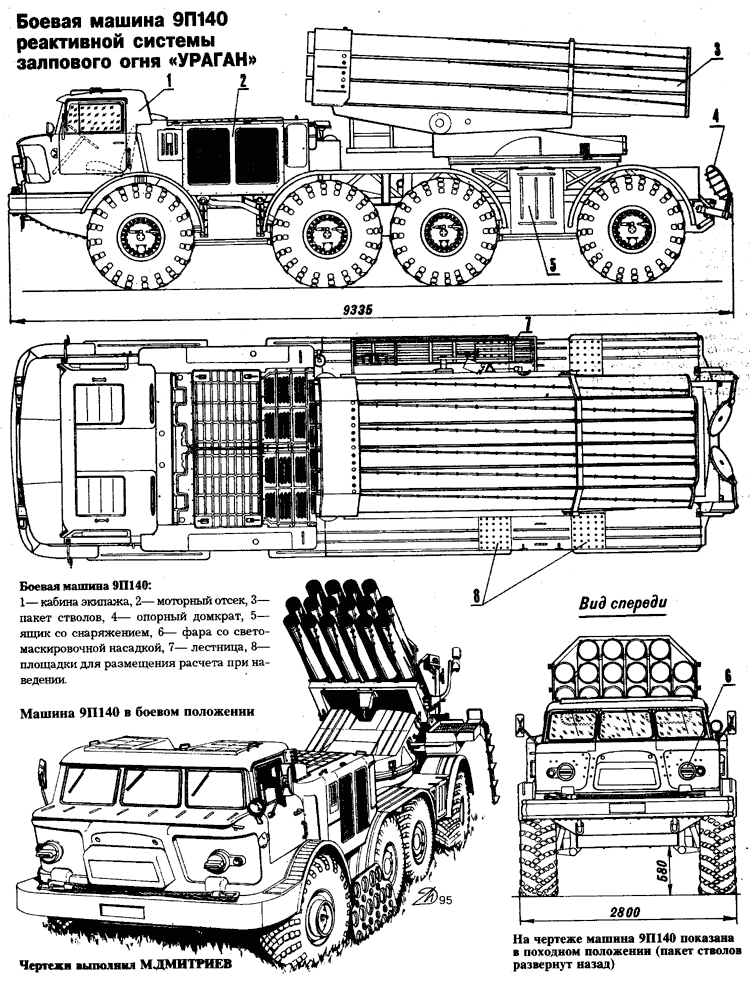
In 1969 - the beginning of 1970, work was carried out to compile and adjust the TTT for experimental design work: “Army MRLS” “Grad-3” (changed to “Uragan” at the beginning of 1970). Apparently, this is the tactical and technical requirements №0010 military unit 64176. The system should have included a combat vehicle, a command vehicle, a transport vehicle, and arsenal equipment. It was proposed to use the following types of warheads of shells: cluster fragmentation action, high-explosive (has a specified fragmentation of the shell), cassette, designed for remote mining. The decision to develop other types of warheads (incendiary, cumulative, agitation, special content) should have been taken by the Ministry of Defense and the Ministry of Mechanical Engineering in the second quarter of 1970 based on the results of the advance design. In the design of projectiles, it was intended to use a solid propellant jet engine with an unregulated nozzle for all warheads in the entire range of operating temperatures. Replaceable nozzles were not. As the base MLRS proposed to use the chassis ZIL-135LM. During the conceptual design, the variants of the combat vehicle and transport vehicle on the tracked chassis of the MT-C conveyor-tractor (variant Tactical and technical requirements for the Grad-3 multiple rocket launcher system and the revision of the command vehicle were to be worked out ). The number of guides should be equal to 20 pcs. when using the chassis from ZIL-135LM and 24 pcs. on the MT-C chassis. But the exact number of guides should have been clarified after reviewing the draft design. For the transport vehicle, the Kraz-253 wheeled chassis was also considered as a base.
From the letter of A. Ganichev (TULGOSNIITOCHMASH) Elagin (GRAU) in the military unit 64176, it became known that the Ministry of Machine-Building and the Ministry of Defense Industry approved the following performers on the rocket launcher system "Grad-3":
Ministry of Engineering:
Research Institute of Chemical Technology (PO Box A-7210, Moscow region, Lyubertsy) for testing the powder charge and ignition system;
The plant "Krasnoarmeeets" and the State Design Bureau for Instrument Engineering (PO Box B-8475, Leningrad) for testing the means of ignition;
Kazan Scientific Research Institute of Chemical Industry (PO Box B-2281, Kazan) for an expelling charge for the cluster head;
Plant named after Maslennikov (PO Box P-6833, Kuibyshev) to create a contact action fuse for a high-explosive warhead, a distance tube for a mechanical type of a cassette warhead;
Institute "Geodesy" (p-i P-6766, Moscow region, Krasnoarmeysk) tests and evaluation of the effectiveness of the warhead;
Research Institute "Search" (pb I-8921, Leningrad) for testing contact fuse for a combat element of a cluster warhead;
Krasnoarmeysky Research Institute of Mechanization (pb A-7690, Moscow Region, Krasnoarmeysk) for testing equipment of a high-explosive warhead, explosive charge for a war element of a cluster warhead;
Orsk Mechanical Plant (PO Box P-6286, Orenburg Region, Orsk) for the manufacture of corps of combat units and engines.
Ministry of Defense Industry:
Perm Machine-Building Plant named after VI. Lenin (pbox P-6760, Perm) by transport and combat vehicles;
All-Union Scientific Research Institute "Signal" (PO Box A-1658, Vladimir region, Kovrov) for the completion of the command vehicle.
Work on the creation of the MLRS “Uragan” was carried out on the basis of the Decree of the USSR Council of Ministers No. 71-26 from 21.01.1970 (Ministry of Machine-building order No. 33 from 28.01.1970).
In order to check the activities that are associated with work to increase the range of fire, for January-February 1971 were planned shooting in the amount of 30 pcs. shells MLRS "Hurricane" from a ballistic installation, located on the gun carriage ML-20. Projectiles with three types of feathering were to be delivered:
- knife type, pen thickness 7 millimeters, opening of the feathers to the longitudinal axis of the projectile at an angle 90 °;
- according to the Grad shells scheme;
- combined (combining the plumage of the projectile knife type and "Grad").
During blowdowns at the Central Aero-Hydrodynamic Institute of the variants of projectiles having three types of feathering, they obtained positive results. The stability margin was about 12 percent.
In 1972, the Tula State Scientific Research Institute of Precision Engineering carried out work on the HB2-154-72 "Single-channel angle stabilization system for Grad and Uragan shells (1 quarter 1972, the beginning of work, 2 quarter 1973, the end) .
In 1972, the search for a single-channel corner stabilization system was conducted in two directions:
- based on the angular velocity sensor with the use of gas-dynamic executive bodies;
- based on the contact angle sensor with the use of powder pulsed executive bodies.
According to the report of the Tula State Scientific Research Institute of Precision Engineering on the work in 1972, this year they carried out theoretical calculations, simulations on analog electronic machines, experimental laboratory studies of a single-channel system of angular stabilization, as well as its elements for rocket unguided “Hurricane” and “Grad” type projectiles. ". Determined the basic requirements for the system and system elements.
The stabilization system consisted of an electron conversion unit, an angular displacement sensor, and gas-dynamic or pulsed-type actuators.
It was determined that the use of a single-channel stabilization system in the Hurricane and Grad shells in 1,5-2 improves their characteristics by accuracy of fire.
On the elements of the corner stabilization system developed drawings, made prototypes and tested in laboratory conditions. By the time of the preparation or submission of the report, the production of a batch of blocks of a single-channel corner stabilization system for flight tests was underway.
In 1972, on the basis of the order of the Chief of the Second General Directorate of the Ministry of Mechanical Engineering No. 17 from 20.12.1970, TulgosNIItochmash carried out a research work on the topic “Study of ways to create long-range projectiles for the Uragan and Grad systems (HB2-110-71g).
In accordance with the target task, they carried out theoretical and experimental work that demonstrated the possibility of increasing the range of firing with shells of the Hurricane and Grad systems through the use of high-pulse fuel and durable materials for the manufacture of the hull.
In 1972, it was recommended to carry out development work on the development of the Uragan system (probably, the development of projectiles or projectile) with a firing range increased to 40 thousand meters.
In 1972, the company completed the initial testing, and presented the system to the ground test trials consisting of:
- unguided missiles with cassette fragmentation (mass 80-85 kg) and high-explosive (mass 100-105 kg) combat units;
- BM 9P140 installed on the chassis of the car ZIL-135ЛМ;
- transport-charging machine 9Т452 installed on the chassis of the car ZIL-135ЛМ;
- arsenal equipment.
During factory testing, the characteristics of the system were obtained, which met the basic tactical and technical requirements:
- the longest firing range of shells having a high-explosive warhead - 34 thousand meters, cluster warhead - 35 thousand meters;
- accuracy of fire:
projectile having a high-explosive warhead: in the direction of WB / X = 1 / 174, in range WD / X = 1 / 197;
projectile having a cassette warhead: in the direction of WB / X = 1 / 152, in range WD / X = 1 / 261;
- reduced the area of destruction by a projectile with a cluster warhead when the combat element approaches the target 85-90 degrees:
open-source manpower - 22090 m2 (Ed. = 10 kgm / cm2);
military equipment 19270 m2 (Ed. = 135 kgm / cm2);
- reduced the area of destruction of the projectile with a high-explosive warhead:
military equipment 1804 m2 (Eud = 240kgm / cm2);
- funnel size:
depth 4,8 m;
8 diameter m.
The fighting machine has 18 guides; salvo time - 9 seconds, ammunition on a transport-loading vehicle, ammunition shells - 1 kit.
The combat vehicle was developed under the leadership of Yury Nikolayevich Kalachnikov, Chief Designer.
The system is constantly being upgraded - for example, today there are a number of modifications of missiles, as well as combat units to these shells.
Currently, the MLRS 9K57 "Hurricane" is in service in the Russian, Kazakh, Belarusian, Ukrainian, Yemeni armies, and, probably, in the Syrian army.
The Uragan multiple rocket launcher was widely used in hostilities in Afghanistan. At the beginning of the 1980-s, it was deployed and used by the Syrian military at the initial stage of the war with Israel. The system was used by federal troops in the Chechen Republic. According to open data, the system was last used by Russian troops in 2008 during the Georgian-South Ossetian conflict.
In Ukraine, the installation of the artillery unit on the KrAZ-6322 chassis, modified for its installation, was carried out. The time of the work is not established.
The composition of the jet system of volley fire "Hurricane" includes:
Fighting machine 9P140;
Transport-loading machine 9Т452;
Missiles
KAUO (complex automated fire control) 1B126 "Kapustnik-B";
Training facilities;
Topographic Survey Vehicle 1Т12-2М;
Radio direction-finding meteorological complex 1B44;
Set of arsenal special equipment and 9Ф381 tool
The 9P140 combat vehicle was carried out on the four-axle chassis of the ZIL-135LPM with high maneuverability and the wheel formula 8x8. The artillery unit consists of a package in which sixteen tubular guides are assembled, a rotary base with sighting devices and guidance mechanisms, a balancing mechanism, and also hydraulic and electrical equipment. Guidance mechanisms equipped with power drives make it possible to direct in the vertical plane a package of guides from 5 to + 55 degrees. The angle of horizontal guidance is ± 30 degrees from the longitudinal axis of the combat vehicle. To increase the stability of the launcher during the shot at the rear of the chassis there are two supports that are equipped with jacks driven by hand. Missiles can be transported directly in the guides. The combat vehicle is equipped with a night vision device and communications equipment (radio station P-123M).
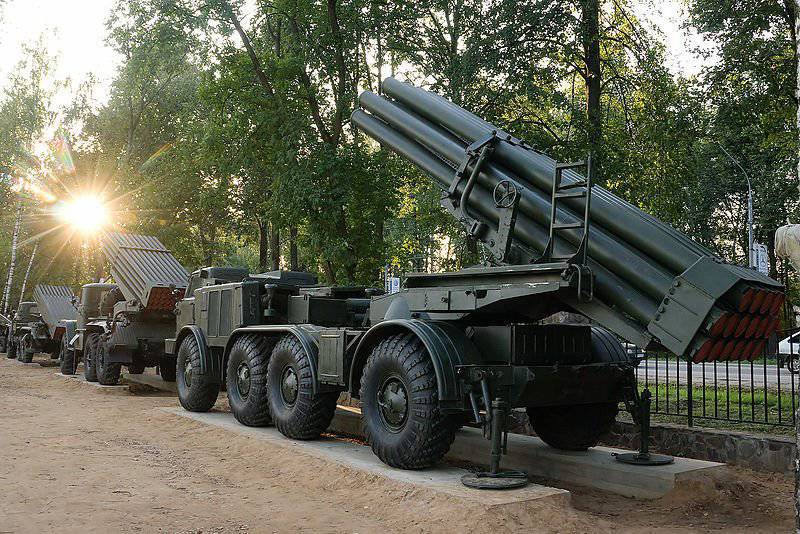
Tubular guides are smooth-walled pipes with a U-shaped screw groove, along which the projectile pin slides during a shot. Thus, it provides its initial spin to give the projectile the stability necessary in flight. The projectile when moving along the rotational trajectory is supported by the blades of a drop-down stabilizer, which are mounted to the longitudinal axis of the projectile at a certain angle. A salvo of one combat vehicle covers an area of more than 42 hectares. The main method of shooting is fire from a closed position. There is the possibility of firing from the cockpit. Calculation of the 9P140 combat vehicle - 6 man (4 man in peacetime): commander of the combat vehicle, driver, gunner (senior gunner), crew number (3 man).
The package of guides is installed on the cradle - a rectangular welded platform. The cradle with the upper machine is connected with the help of two semi-axes, around which it swings (turns) when pointing at elevation angles. The totality of the cradle, package guides, a number of assemblies and parts of the locking mechanism, sight bracket, ignition system and others is the swinging part. With the help of the rotating part of the combat vehicle, the required azimuth angle is attached to the guide package. The rotating part consists of the swinging part, the upper machine, the balancing, lifting and turning mechanism, shoulder strap, gunner's platform, manual guidance drive, the locking mechanism of the swinging part, the hydraulic lock of the swinging part, the locking mechanism of the rotating part. The balancing mechanism is a partial compensation of the moment of weight of the swinging part. It consists of mounting parts and a pair of torsions. Rotary and lifting mechanisms are used to guide the package guides in the horizontal plane and the angle of elevation. The main method of targeting is electric. When repairing and in case of failure, a manual drive is used. The locking mechanisms are fixed moving parts of the installation during movement. The hydraulic mechanism of the swinging part unloads the lifting mechanism during firing and prevents the knocking on the elevation angles.
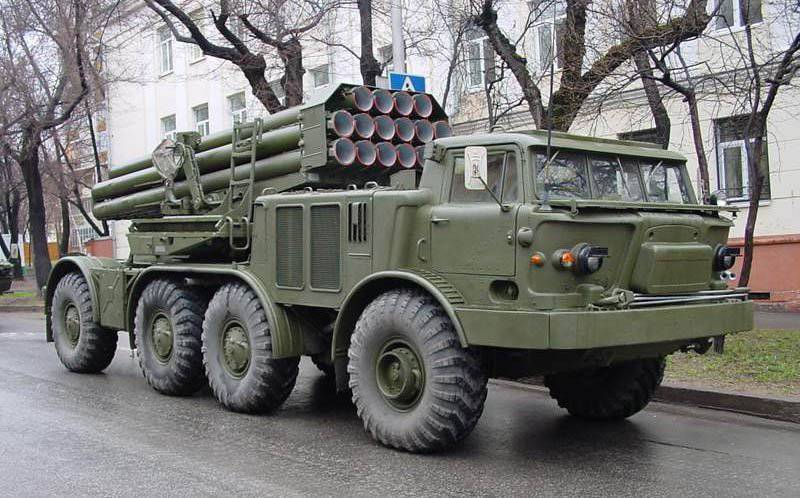
The combat vehicle has a panoramic mechanical sight D726-45. As a goniometer and a sighting device in the sight use a standard gun panorama PG-1M.
The launch system of the 9P140 combat vehicle is provided with:
- safe operation of the calculation, which serves the combat vehicle when firing;
- maintenance of salvo and solitary fire while in the calculation cabin;
- conducting salvo and solitary fire while in the shelter of the calculation at a distance of up to 60 meters from the combat vehicle;
- firing in case of failure of power sources and main blocks of firing chains.
The launch system provides the possibility of salvo fire at a constant pace (the launch of 16 rockets takes place with a 0,5 pace of a second) and the so-called “ragged” rate of fire (the first 8 rockets are launched at intervals of 0,5 seconds, the rest of the missiles are at 2 intervals). Through the use of "ragged" rate of fire can significantly reduce the frequency and amplitude of oscillations of a combat vehicle, and, consequently, improve the accuracy of fire.
For loading the launcher, the 9Т452 transport-loading vehicle, developed on the same chassis combat vehicle, is used. Each 9Т452 charging machine can transport 16 rockets. The machine provides loading (discharging) without specials. preparation of a position, including from any transport vehicle, from another transport-loading vehicle or from the ground. The reloading process is mechanized, the charging time is 15 minutes. Load capacity 300 kg.
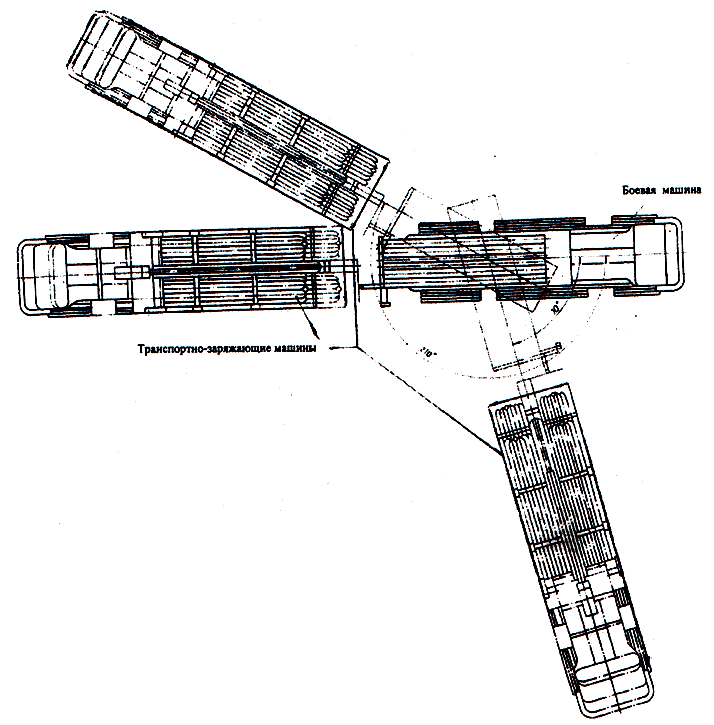
The equipment of the transport-charging machine consists of a frame, a crane, a tray with a rammer, cargo carts, load handling equipment, an operator’s platform, a docking device, a rod, a crane turning gearbox, electrical equipment, a alignment mechanism, spare parts. Tray with rammer - foldable beam, which moves the pusher with a rocket. The alignment mechanism aligns the axis of the rocket, which is in the tray, and the axis of the guide tube. The left and right carts are designed to accommodate missiles. The transport-charging machine has three electric drives, which carry out: raising / lowering of rockets, turning the crane, sending rockets into guides.
The combat vehicle is loaded in the following order from the upper tier: lift the rocket, put it in the tray, unhook the load gripping device, send the rocket into the guide.
A special feature of the four-wheeled wheel chassis ZIL-135LMP was the location of the power plant behind the four-seater cabin. This power plant consisted of two eight-cylinder V-shaped carburetor engines ZIL-375. At 3200 rpm, each engine develops power up to 180 HP. The transmission has an onboard circuit: the wheels on each side rotate by an independent engine through a separate gearbox, the onboard gearboxes and transfer cases. The wheels of the first and fourth axles are steerable, with independent torsion bar suspension and shock absorbers. The wheels of the middle axles are close together, do not have an elastic suspension and are rigidly attached to the frame. The machine is equipped with a centralized tire pressure control system. The machine has a very high throughput and speed characteristics. When driving at full load on a highway, the maximum speed is 65 kilometers per hour, without prior preparation, it can overcome fords to a depth of 1,2 meters. The fuel range is 500 km.
The ammunition of the Uragan multiple rocket launcher consists of the following missiles:
- 9М27Ф with a high-explosive fragmentation warhead;
- 9М27К having a cassette warhead with fragmentation warheads;
- 9М27С having an incendiary head;
- 9М59, 9М27К2, 9М27К3 with a cassette warhead with anti-tank mines;
- 9М51 having the head part of the volume-detonating action (during the war in Afghanistan showed high efficiency).
The maximum firing range - 35 thousand m, for destruction at smaller distances on the rocket wear rings, which inhibit it in flight. The range of a cluster with a small ring is 11-22 km, an unguided rocket 9М27Ф is 8 - 21 km. In the case of using a large braking range, the cluster projectile is 9 - 15 km, and the 9М27Ф projectile is 8 - 16 km.
The complex can be operated in conditions of use by the enemy of nuclear, bacteriological, chemical weapons at different times of the year and day, at an air temperature of -40 ... + 50 ° С. in different climatic conditions.
The multiple launch rocket system "Hurricane" can be transported by water, rail or air.
Performance characteristics of the MLRS 9P140 MLRS “Uragan”:
The mass of the combat vehicle in the combat position - 20 tons;
Mass of the combat vehicle without calculating and projectiles - 15,1 tons;
Dimensions in the traveling position:
Length - 9,630 m;
Width - 2,8 m;
Height - 3,225 m;
Wheel formula - 8x8
Number of guides - pcs; 16;
Rotation of guides - 240 degrees;
Recharge time - 15 minutes;
Cruising on the highway - 500 km;
The transfer time of the combat vehicle from the marching to the combat position is no more than - 3 minutes;
The time of firing position after making a volley less than - 1,5 minutes;
The range of temperatures for combat use is from -40 to + 50 ° С;
Surface wind - up to 20 m / s;
Relative air humidity at 20..25 ° С - up to 98%;
Surface air dust content - up to 2 g / m3;
Application height above sea level - up to 3000 m;
General characteristics of rockets:
Caliber - 220 mm
The weight of the solid powder charge - 104,1 kg
The maximum firing range - 35 km;
The minimum firing range - 8 km;
Combat use temperature range - from -50 to + 50 ° С;
The temperature range of short-term (up to 6 hours) PC stay is from -60 to + 60 ° С.
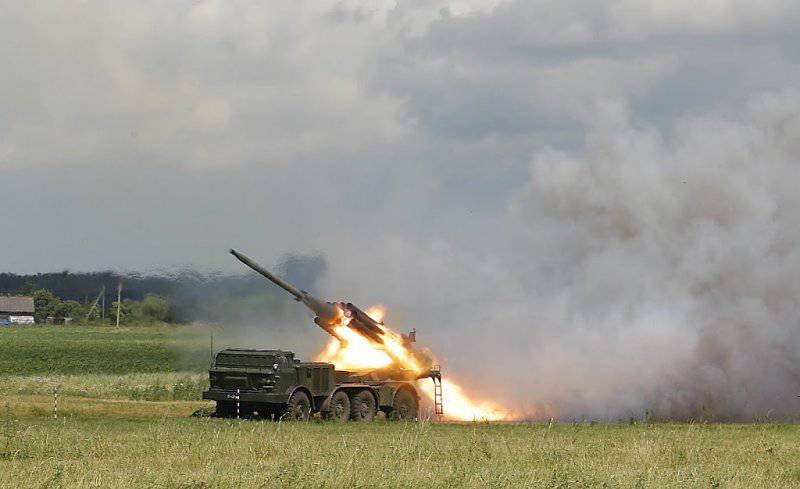
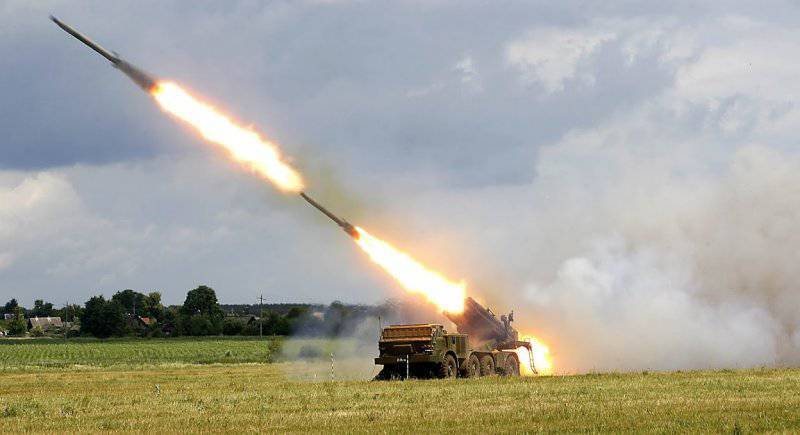
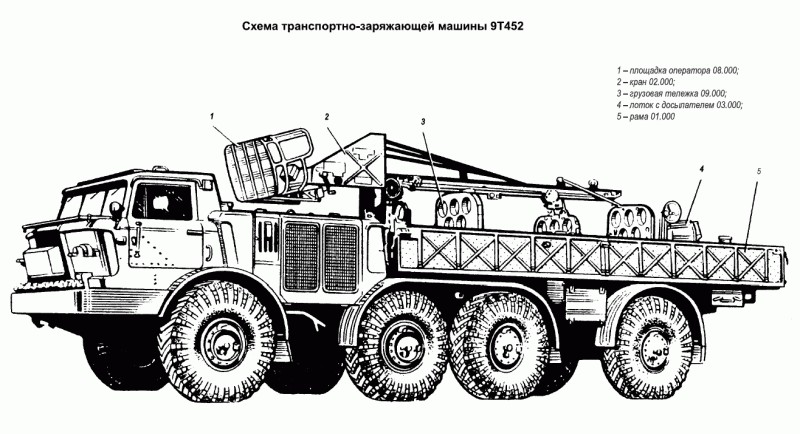
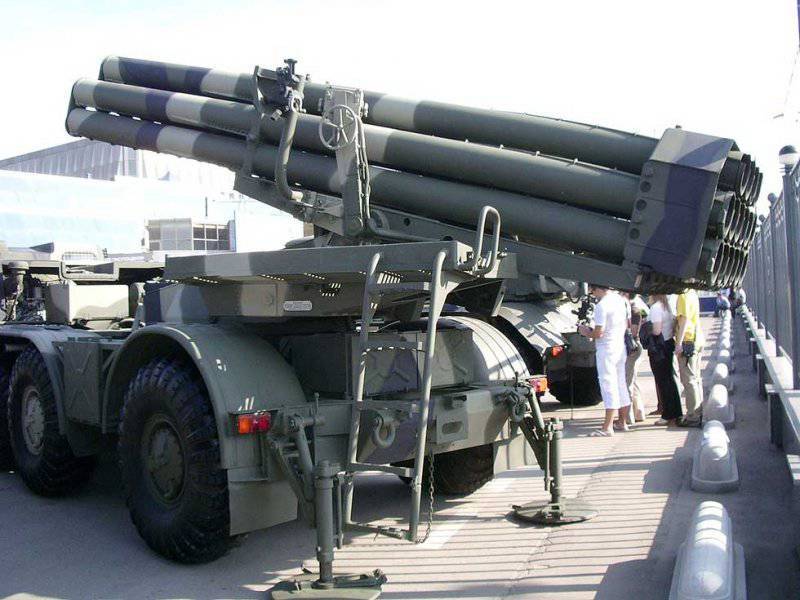
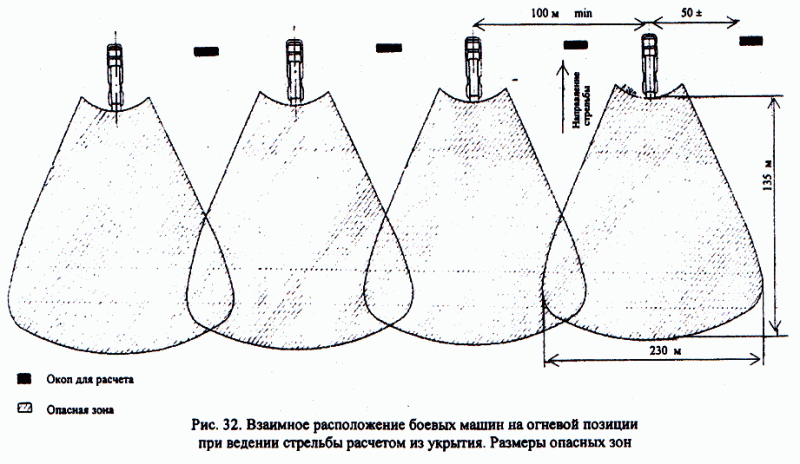
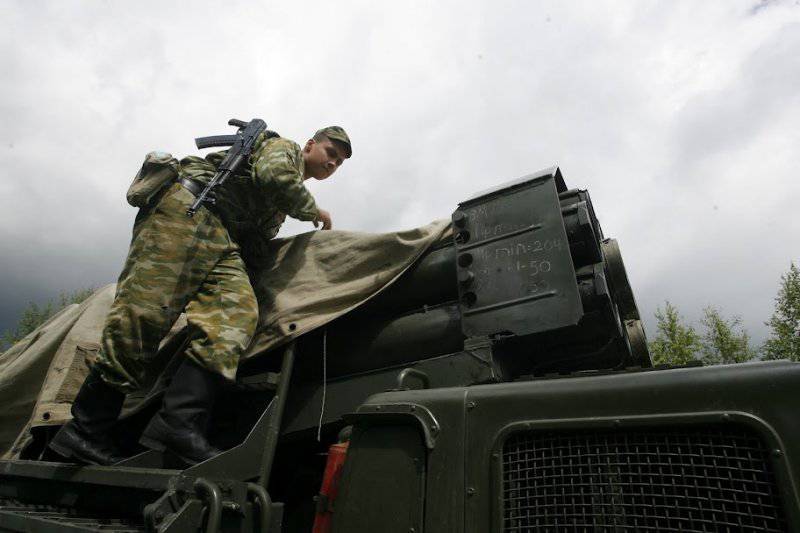
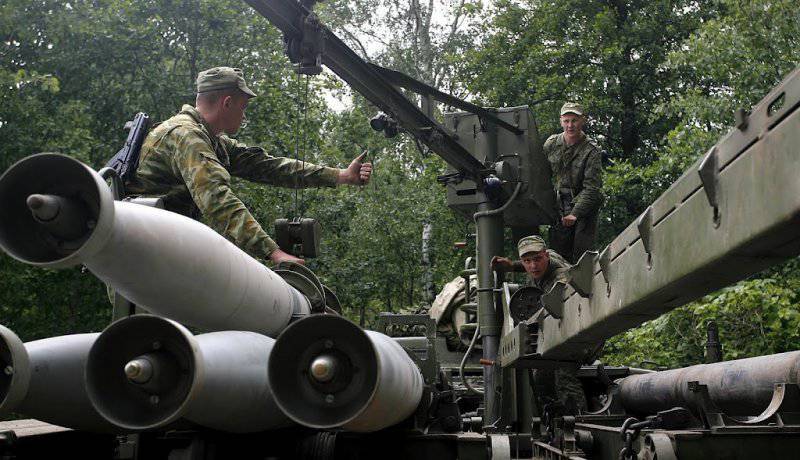
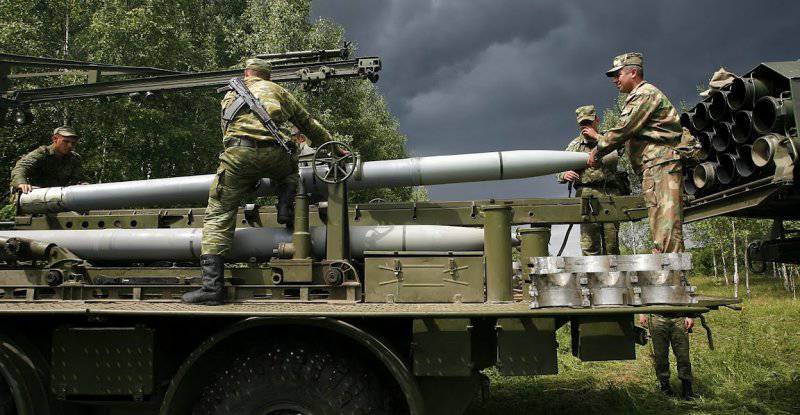
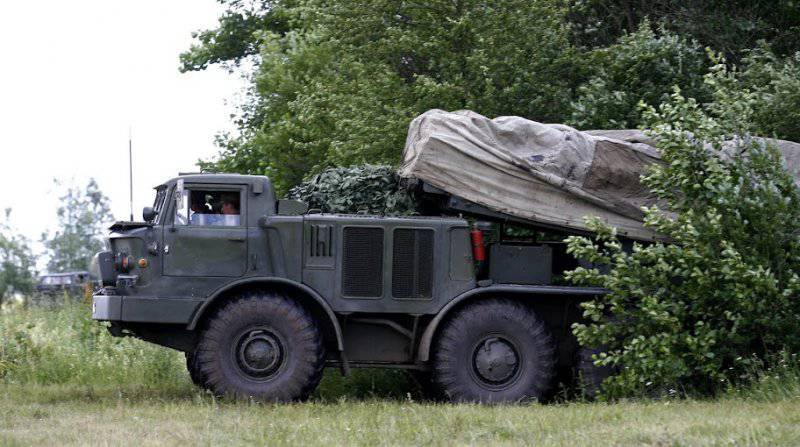
Information